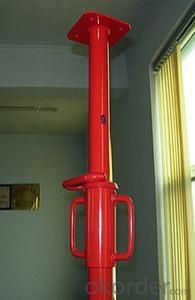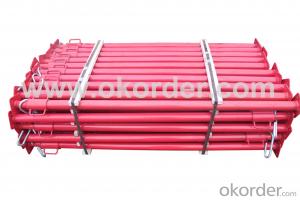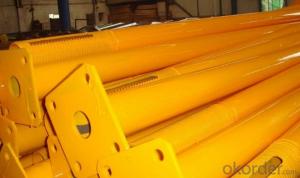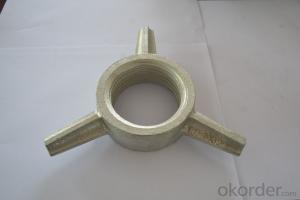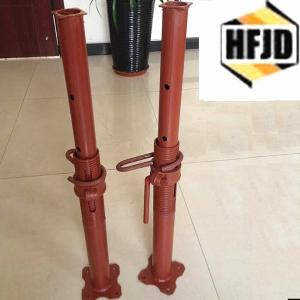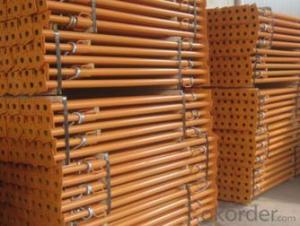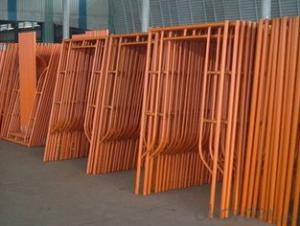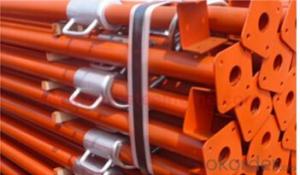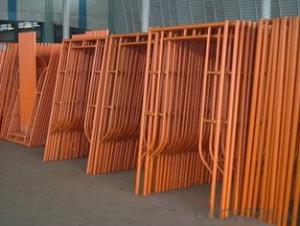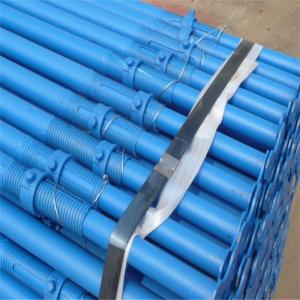Adjustable Scaffolding Steel prop 48mm 56mm
- Loading Port:
- Tianjin
- Payment Terms:
- TT OR LC
- Min Order Qty:
- 10000 PCS
- Supply Capability:
- 10000 PCS/month
OKorder Service Pledge
OKorder Financial Service
You Might Also Like
Quick Details
| size: | Spanish, Italian, Middle East or German prop | Color: | red, yellow, blue or as your requirement | Surface Treatment: | painted, ele-galvanized or powder coated |
Packaging & Delivery
| Packaging Detail: | factory steel pallet, safe and atandard package or as customer's requirement |
| Delivery Detail: | 15-20days according to your ordered quantity |
Specifications
1. Sizes: As per customer's demands
2. Q235
3..Surface treatment:Hot dip galvanzied,,Powder coated, Painted
Features of steel Prop:
1. Scaffolding adjustable steel props consists of outer tube, inner tube, prop nut, top plate and base plate,5 components.
2.Adjustable steel props is fast to build up,which can save 60% time and manpower than traditional scaffoldings.
3.Workers can handle it easily due to the simple structure.
4. Scaffolding adjustable Steel Props is an ideal and cost-effective product to support concrete,temporary formwork,slabs and beams.
5. Scaffolding adjustable Steel Props is very easy to transport and stock. The high protected painted surface means it is not easy to rust.
6. The heavy duty type of steel props that can load more than 1 ton for each piece steel prop.
- Q:Are steel props suitable for temporary structures?
- Yes, steel props are suitable for temporary structures. Steel props are strong, durable, and adjustable, making them ideal for providing temporary support and stability to structures during construction or renovation projects. Their robustness and ability to bear heavy loads make them a reliable choice for temporary structures.
- Q:Can steel props be used for supporting temporary catwalks?
- Yes, steel props can be used for supporting temporary catwalks. Steel props, also known as adjustable steel props or steel shores, are commonly used in construction and scaffolding to provide temporary support to various structures, including catwalks. These props are designed to be adjustable in height, making them versatile and suitable for different applications, including supporting temporary structures like catwalks. Steel props offer high load-bearing capacity and stability, making them a reliable choice for providing support to catwalks, which are typically used for accessing elevated areas during construction, maintenance, or events. Additionally, steel props are easy to assemble and disassemble, making them convenient for temporary structures that may need to be set up and removed quickly. Overall, steel props are a suitable and commonly used choice for supporting temporary catwalks.
- Q:Are steel props cost-effective compared to other support systems?
- Yes, steel props can be considered cost-effective compared to other support systems for various reasons. Firstly, steel props are highly durable and have a longer lifespan compared to other materials such as timber or aluminum. This means that they can be reused multiple times, reducing the need for frequent replacements and ultimately saving costs in the long run. Additionally, steel props are known for their high load-bearing capacity, providing reliable support for heavy structures. This can result in fewer props being needed compared to other support systems, reducing the overall cost of materials required for a project. Moreover, steel props are adjustable in height, allowing for versatility and adaptability in various construction scenarios. This flexibility eliminates the need for custom-made supports, which can be costly and time-consuming. Furthermore, steel props are relatively easy to install, dismantle, and transport due to their lightweight and modular design. This can significantly reduce labor costs and time spent on construction sites. Lastly, steel is a widely available and cost-effective material, making steel props more affordable compared to support systems made from materials that are scarce or expensive. Taking all these factors into account, it can be concluded that steel props are a cost-effective choice for support systems in construction projects, offering durability, versatility, and efficiency while minimizing overall expenses.
- Q:How do steel props compare to hydraulic shoring systems?
- Steel props and hydraulic shoring systems are both commonly used in construction projects for temporary support of structures and excavation works. However, they have distinct differences and advantages, which can affect their suitability for different applications. Steel props, also known as acrow props or adjustable steel props, are simple and robust devices made of steel tubes with adjustable lengths. They are manually positioned and secured in place to provide vertical support to walls, ceilings, slabs, or trenches. Steel props are versatile and easy to install, making them suitable for a wide range of applications. They can be adjusted to different heights and can withstand significant loads. However, they require manual labor for installation and adjustment, which can be time-consuming and physically demanding. On the other hand, hydraulic shoring systems utilize hydraulic cylinders to provide support and stabilization. These systems are more complex and require specialized equipment and expertise for installation. Hydraulic shoring systems offer the advantage of being able to support heavier loads and provide more precise and controlled adjustments. They are particularly useful in situations where there is a need for frequent modifications or where the loads are constantly changing. Additionally, hydraulic shoring systems are quicker to install and require less labor compared to steel props. In terms of safety, both steel props and hydraulic shoring systems are designed to prevent collapses and ensure the stability of the surrounding structures. However, hydraulic shoring systems generally provide better safety features, such as built-in hydraulic pressure gauges, which allow for real-time monitoring of the system's stability. The choice between steel props and hydraulic shoring systems depends on various factors, including the specific requirements of the project, the load-bearing capacity needed, the desired level of adjustability, and the available resources. Steel props are often preferred for smaller-scale projects or when a simpler and more cost-effective solution is sufficient. Hydraulic shoring systems, on the other hand, are commonly used in larger and more complex projects where heavy loads, frequent adjustments, and enhanced safety features are necessary. Ultimately, both steel props and hydraulic shoring systems have their own advantages and limitations. It is crucial to assess the specific project requirements and consult with engineering professionals to determine the most suitable option for ensuring the safety and stability of the construction site.
- Q:Are there any environmental considerations when using steel props?
- Yes, there are environmental considerations when using steel props. Steel production requires significant amounts of energy and resources, contributing to greenhouse gas emissions and environmental degradation. Additionally, the extraction and processing of steel raw materials can have negative impacts on ecosystems and local communities. Proper disposal or recycling of steel props at the end of their life cycle is also essential to minimize environmental harm.
- Q:Can steel props be used in mining or tunneling projects?
- Yes, steel props can be used in mining or tunneling projects. Steel props are strong, durable, and can provide the necessary support and stability required in such projects. They can be used to reinforce tunnels, prevent cave-ins, and support the surrounding rock formations.
- Q:What are the different types of steel prop braces available?
- There exists a variety of steel prop braces, each catering to specific applications and needs. 1. Adjustable Steel Props: The most commonly used steel prop braces in construction projects are the adjustable ones. These props comprise a steel tube with a screw mechanism that enables easy height adjustment. They are highly versatile and suitable for a wide range of applications. 2. Push-Pull Props: Also referred to as shore props, push-pull props are utilized to support horizontal loads in construction. They consist of two telescopic steel tubes connected by threading. Typically, they are employed to provide support for formwork, scaffolding, and other temporary structures. One tube pushes against the load while the other is pulled to provide additional support. 3. Acrow Props: Acrow props are lightweight and adjustable steel prop braces commonly used in construction. They are easy to handle and can be quickly adjusted to the desired height. Acrow props find application in supporting beams, walls, and other structures during construction or renovation projects. 4. Flying Props: Flying props, also known as flying shores, are utilized to support upper floors of a building while the lower floors are being constructed. They consist of a steel prop brace attached to the lower floor, extending through openings in the upper floors. Flying props offer temporary support until the permanent structure is in place. 5. Heavy Duty Props: Heavy-duty props are designed for applications that require additional strength and load-bearing capacity. These props are constructed using thicker and stronger steel tubes, enabling them to support heavier loads. They are commonly employed in industrial projects like bridge construction or building renovation. 6. Tilt Props: Tilt props, also called raker props, are employed to provide horizontal support to walls or structures that are not plumb. These props include a vertical steel prop brace connected to a diagonal tube anchored to the ground or another structure. Tilt props aid in stabilizing leaning walls or structures during construction or renovation. Selecting the appropriate steel prop brace according to project requirements, including load-bearing capacity, adjustability, and structural stability, is crucial. Consulting with a structural engineer or construction professional can assist in determining the most suitable steel prop brace for a specific application.
- Q:Do steel props comply with building codes and regulations?
- Yes, steel props comply with building codes and regulations. They are commonly used in construction projects as temporary supports for various structural elements, such as floors, walls, and beams. Steel props are designed and manufactured to meet specific load-bearing requirements and safety standards outlined in building codes and regulations. They undergo rigorous testing and are certified to ensure their reliability and compliance with these standards.
- Q:Can steel props be used for temporary support in airport construction?
- Temporary support in airport construction can be provided by steel props. These props, also called adjustable steel props or steel acrow props, are commonly utilized in construction projects to offer temporary support to structures or excavations. They can be easily installed and removed, as well as adjusted in height, making them suitable for various construction applications, including airport construction. Made from high-quality steel, steel props are highly durable and capable of withstanding heavy loads. They are frequently employed to support formwork, scaffolding, and other temporary structures during construction. In the context of airport construction, steel props can be utilized to support temporary structures such as formwork for concrete works, scaffolding for maintenance or equipment installation, or even during excavation works. The adjustable height feature of steel props allows for flexibility in accommodating different heights and requirements in airport construction. They can be extended or retracted to reach the desired height, and their load-bearing capacity can be adjusted accordingly. This flexibility makes them an excellent choice for supporting temporary structures in airport construction, as the project's needs and requirements can vary depending on the specific stage of construction. Moreover, steel props are easy to install and remove, resulting in time and labor savings during airport construction. They can be quickly assembled and dismantled, facilitating efficient resource utilization and reducing construction timelines. This is particularly crucial in airport construction, where time is often a critical factor. In summary, steel props are a dependable and versatile solution for providing temporary support in airport construction. Their durability, load-bearing capacity, adjustability, and ease of installation make them suitable for a wide range of applications, ensuring the safety and efficiency of the construction process.
- Q:What are the different weight classes available for steel props?
- Steel props can come in a range of weight classes depending on the manufacturer and their offerings. Some commonly available weight classes for steel props are as follows: 1. Light Duty: These props are designed for lighter loads and have a maximum load capacity of up to 10 kN. They are suitable for smaller construction projects or temporary support requirements. 2. Medium Duty: This class includes props with a maximum load capacity ranging from 10 kN to 20 kN. They are stronger than light duty props and can handle heavier loads. Medium-duty props are commonly used in residential and commercial construction projects. 3. Heavy Duty: These props are designed to bear significantly heavier loads and have a maximum load capacity of 20 kN or more. They are typically used in large-scale construction projects like high-rise buildings or bridges. Heavy-duty props provide additional stability and strength to ensure the structure's safety. It's important to note that weight classes may vary across manufacturers, so it's crucial to refer to the specific product specifications to determine the appropriate weight class for your construction needs. Furthermore, it's always recommended to consult with a structural engineer or construction professional to ensure the correct selection and usage of steel props for any given project.
1. Manufacturer Overview |
|
|---|---|
| Location | |
| Year Established | |
| Annual Output Value | |
| Main Markets | |
| Company Certifications | |
2. Manufacturer Certificates |
|
|---|---|
| a) Certification Name | |
| Range | |
| Reference | |
| Validity Period | |
3. Manufacturer Capability |
|
|---|---|
| a)Trade Capacity | |
| Nearest Port | |
| Export Percentage | |
| No.of Employees in Trade Department | |
| Language Spoken: | |
| b)Factory Information | |
| Factory Size: | |
| No. of Production Lines | |
| Contract Manufacturing | |
| Product Price Range | |
Send your message to us
Adjustable Scaffolding Steel prop 48mm 56mm
- Loading Port:
- Tianjin
- Payment Terms:
- TT OR LC
- Min Order Qty:
- 10000 PCS
- Supply Capability:
- 10000 PCS/month
OKorder Service Pledge
OKorder Financial Service
Similar products
New products
Hot products
Related keywords
